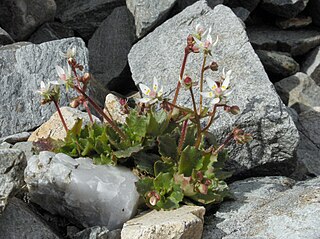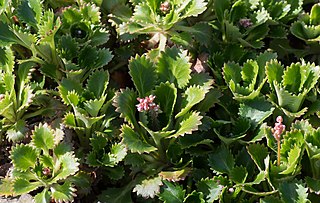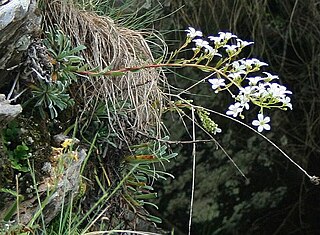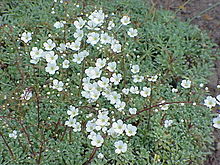
Geranium is a genus of 422 species of annual, biennial, and perennial plants that are commonly known as geraniums or cranesbills. They are found throughout the temperate regions of the world and the mountains of the tropics, with the greatest diversity in the eastern part of the Mediterranean region.

Hosta is a genus of plants commonly known as hostas, plantain lilies and occasionally by the Japanese name gibōshi. Hostas are widely cultivated as shade-tolerant foliage plants. The genus is currently placed in the family Asparagaceae, subfamily Agavoideae, and is native to northeast Asia. Like many "lilioid monocots", the genus was once classified in the Liliaceae. The genus was named by Austrian botanist Leopold Trattinnick in 1812, in honor of the Austrian botanist Nicholas Thomas Host. In 1817, the generic name Funkia was used by German botanist Kurt Sprengel in honor of Heinrich Christian Funck, a collector of ferns and alpines; this was later used as a common name and can be found in some older literature.

Saxifraga × urbium, London pride, is an evergreen perennial garden flowering plant. Alternative names for it include St. Patrick's cabbage, whimsey, prattling Parnell, and look up and kiss me. Before 1700 the “London pride” appellation was given to the Sweet William.

Micranthes stellaris, synonym Saxifraga stellaris, the starry saxifrage or hairy kidney-wort, is an Arctic–alpine species in the family Saxifragaceae. It produces panicles of 5–10 white flowers on a stem up to 20 cm (7.9 in) tall, rising from a basal leaf rosette. One subspecies is found from eastern Canada to Russia, including the British Isles, while another is found in the mountains of southern Europe.

Saxifraga paniculata is an alpine species of flowering plant in the saxifrage family, with native distribution in the temperate northern hemisphere. Common names include alpine saxifrage, encrusted saxifrage, lifelong saxifrage, lime-encrusted saxifrage, livelong saxifrage, white mountain saxifrage, and silver saxifrage.

Saxifraga stolonifera is a perennial flowering plant known by several common names, including creeping saxifrage, strawberry saxifrage, creeping rockfoil, Aaron's beard, mother of thousands, roving sailor, and strawberry begonia or strawberry geranium.

Saxifraga tridactylites, the rue-leaved saxifrage or "nailwort", is a species of plant in the family Saxifragaceae.

Micranthes nivalis is a plant species in the saxifrage family. It is commonly called snow saxifrage or (ambiguously) alpine saxifrage.

Saxifraga granulata, commonly called meadow saxifrage, is a species of flowering plant in the family Saxifragaceae. It is native to Europe and Morocco.

Saxifraga cuneifolia, the lesser Londonpride, shield-leaved saxifrage or spoon-leaved saxifrage, is a herbaceous perennial plant belonging to the Saxifragaceae family.

Saxifraga spathularis, the St Patrick's cabbage, is a species of saxifrage native to Ireland, Portugal, and Spain. It is a member of the so-called Lusitanian flora, a small set of plants which are native to Ireland but inexplicably absent from Great Britain. It consists of a basal rosette of elongate obovate succulent leaves around an upright leafless flowering stem. It seems to grow best in humus-rich alpine habitats among acidic rocks. With Saxifraga umbrosa it is a parent of Saxifraga × urbium.

Micranthes is a genus of flowering plants in the saxifrage family. It was formerly included within the genus Saxifraga until recent DNA evidence showed the members of what is now Micranthes are more closely related to Boykinia and Heuchera than to other members of the genus Saxifraga.

Saxifraga fortunei (齿瓣虎耳草), the fortune saxifrage, is a species of flowering plant in the family Saxifragaceae, native to China, Japan and Korea. Growing to just 40 cm (16 in) tall and broad, it is a shade-loving herbaceous perennial with large round fleshy leaves. Slender branched stalks bear panicles of small white starry flowers in summer. The two lower petals of each bloom are significantly longer than the others. Both the flowers and the leaves are sometimes flushed red or pink.

Saxifraga callosa, the limestone saxifrage, is a species of flowering plant in the family Saxifragaceae, that is native to maritime alpine habitats in Western Europe. Growing to 50 cm (20 in) tall by 100 cm (39 in) broad, it is a clump-forming evergreen perennial with rosettes of narrow grey-green leaves that are coated in lime. The starry, pure white flowers are borne in long panicles in spring.

Saxifraga umbrosa, called true London pride, none-so-pretty, king's feather, kiss-me-quick, leaf of St Patrick, look-up-and-kiss-me, mignonette of the French, Nancy-pretty, prattling Parnell, Pyrenean saxifrage, sailor plant, St Anne's needlework, St Patrick's cabbage, and whimsey, although some of these names may more properly belong to Saxifraga spathularis, or its hybrid with S. spathularis, Saxifraga × urbium, is a species of flowering plant in the family Saxifragaceae. It is native to the Pyrenees, and has been introduced elsewhere in Europe, and to southern Chile. Its cultivar 'Clarence Elliott' has gained the Royal Horticultural Society's Award of Garden Merit.

Saxifraga hypnoides, called mossy saxifrage, cut-leaved saxifrage, Dovedale moss, Eve's cushion, Indian moss, lady's cushion, and queen's cushion, is a species of flowering plant in the family Saxifragaceae. It is native to northwestern Europe; Iceland, the Faroe Islands, Norway, Ireland, Great Britain, Belgium, and France, and has been introduced to Czechia, the Eastern Himalayas, and Tibet. In the north of its range a tetraploid form predominates, and in the south a diploid form is more likely to be found.

Boykinia richardsonii is a species of flowering plant in the family Saxifragaceae, endemic to Alaska and the adjacent Canadian territory of Yukon. It is commonly known as Richardson's brookfoam, but has also been called Alaska boykin, bearflower, Richardson's boykin and Richardson's saxifrage. "Bearflower" reflects its popularity with grizzly bears as forage in the summer months when it flowers.

























